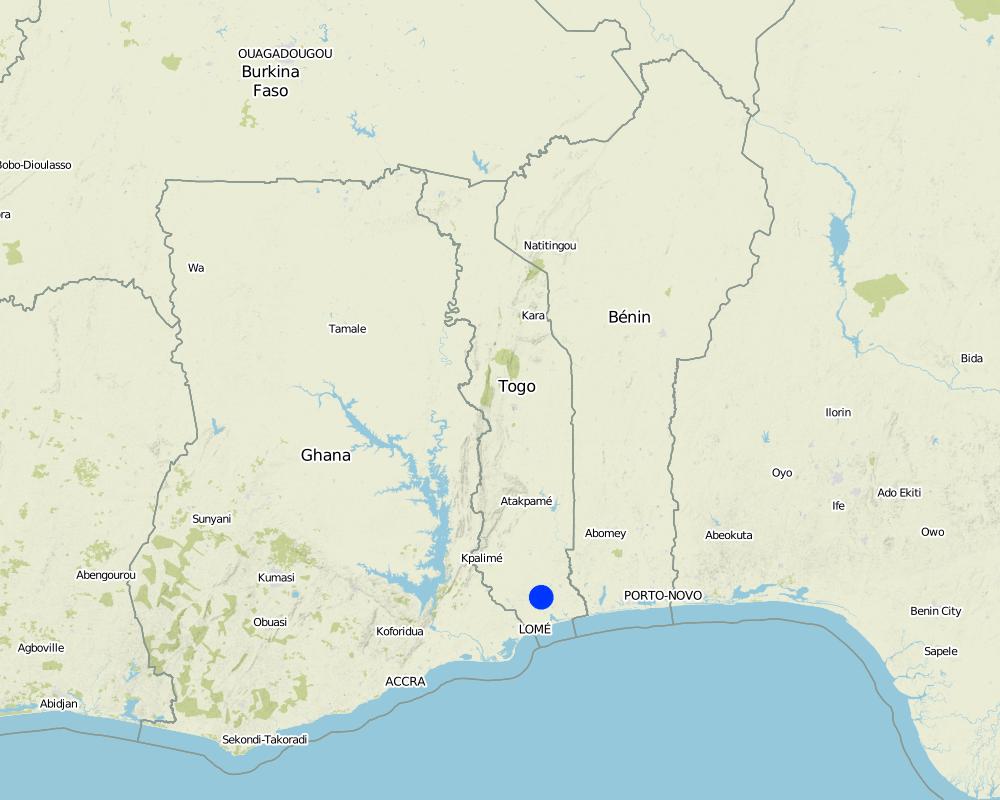新的SLM方法 [多哥]
- 创建:
- 更新:
- 编制者: Philippe Zahner
- 编辑者: –
- 审查者: Fabian Ottiger
approaches_2641 - 多哥
查看章节
全部展开 全部收起1. 一般信息
1.2 参与方法评估和文件编制的资源人员和机构的联系方式
有助于对方法进行记录/评估的机构名称(如相关)
Swiss Agency for Development and Cooperation (DEZA / COSUDE / DDC / SDC) - 瑞士1.3 关于使用通过WOCAT记录的数据的条件
编制者和关键资源人员接受有关使用通过WOCAT记录数据的条件。:
是
2. SLM方法的描述
2.5 采用该方法的国家/地区/地点
国家:
多哥
区域/州/省:
Maritime
Map
×2.9 推动或妨碍实施本办法所适用的技术的条件
法律框架(土地使用权、土地和水使用权)
- 启动
The existing land ownership, land use rights / water rights greatly helped the approach implementation: les exploitants ??taient propri??taires de leurs acquises par achat
3. 相关利益相关者的参与和角色
3.1 该方法涉及的利益相关者及其职责
- 当地土地使用者/当地社区
Men are the human groups that are more interested in agriculture. Retirement, man seeks his safety? Financial operation in land use contrary to wife
3.2 当地土地使用者/当地社区参与该方法的不同阶段
| 当地土地使用者/当地社区的参与 | 指定参与人员并描述活动 | |
|---|---|---|
| 启动/动机 | 互动 | Workshops / seminars; They have a less precise idea of technology and the specialist helps them to clarify it |
| 计划 | 互动 | Method of access to participatory research |
| 实施 | 互动 | responsibility at minor stages; The operators execute the plan and the program of the activities under the supervision of the specialists |
| 监测/评估 | 无 | |
| Research | 无 |
4. 技术支持、能力建设和知识管理
4.1 能力建设/培训
是否为土地使用者/其他利益相关者提供培训?:
是
涵盖的主题:
Corridor cultivation and windbreaks, planting techniques and hedge management
4.2 咨询服务
土地使用者有权使用咨询服务吗?:
是
说明/注释:
Advisory services are very adequate to ensure the continuation of land conservation activities; Resources is available at ITRA, ICAT, to pay the Supervision of Operators
4.3 机构强化(组织发展)
是否通过这种方法建立或加强了机构?:
- 是,少许
具体说明机构的强化或建立程度:
- 本地
4.4 监测和评估
监测和评估是该方法的一部分吗?:
是
注释:
bio-physical aspects were ad hoc monitored through observations
technical aspects were ad hoc monitored through observations
economic / production aspects were regular monitored through measurements
There were no changes in the Approach as a result of monitoring and evaluation
4.5 研究
研究是该方法的一部分吗?
是
提供进一步的细节,并指出是谁做的研究:
Technical improvements are constantly sought and the market conditions are also studied
5. 融资和外部物质支持
5.2 为土地使用者提供财政/物质支援
土地使用者是否获得实施该技术的财政/物质支持?:
否
5.3 对特定投入的补贴(包括劳动力)
如果土地使用者的劳动力是一项重要的投入,那么是不是:
- 自愿
注释:
The operators themselves solicit specialists
5.4 信用
是否根据SLM活动的方法给予信用值?:
否
6. 影响分析和结论性陈述
6.1 方法的影响
该方法是否帮助土地使用者实施和维护SLM技术?:
- 否
- 是,很少
- 是,中等
- 是,支持力度很大
am??lioration de la fertilit?? des sols, de sa capacit?? de retention d'eau
Did other land users / projects adopt the Approach?
- 否
- 是,很少
- 是,中等
- 是,支持力度很大
les exploitants qui d??couvrent la technologie mise en place et l'approche qui lui est associ??e sont int??ress??s et l'adoptent aussi
6.4 该方法的长处/优点
| 土地使用者眼中的长处/优势/机会 |
|---|
| 1) am??lioration des connaissances techniques et ??conomiques (How to sustain/ enhance this strength: continuer la formation avec lui) |
| 2) am??lioration des rendements de culture (How to sustain/ enhance this strength: lui fournir des docuements de gestion technique des cultures) |
| 编制者或其他关键资源人员认为的长处/优势/机会 |
|---|
| 1) responsabilisation des exploitants (How to sustain/ enhance this strength: lui confier beaucoup plus d'ex??cution des plans d'action) |
| 2) am??lioration des connaissances agro-??conomiques de l'exploitant (How to sustain/ enhance this strength: renforcer la formation en fonction du niveau intellectuel des exploitants) |
| 3) cr??ation de lien de confiance entre l'exploitant et vulgarisateur (How to sustain/ enhance this strength: montrer ?? l'exploitant le bien fonc?? de l'approche) |
6.5 该方法的弱点/缺点以及克服它们的方法
| 编制者或其他关键资源人员认为的弱点/缺点/风险 | 如何克服它们? |
|---|---|
| difficile ?? appliquer si l'exploitant n'est pas instruit | essayer la formation en langue locale |
7. 参考和链接
7.1 方法/信息来源
- 实地考察、实地调查
- 与土地使用者的访谈
链接和模块
全部展开 全部收起链接
无链接
模块
无模块


